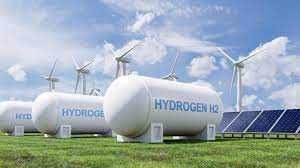China is expected to be the world’s largest importer of clean hydrogen, requiring 13 million tonnes of imported hydrogen a year by 2030 due to the huge amount of clean energy required to decarbonise its different sectors, according to a report released by Deloitte on Thursday.
Europe’s demand will amount to 10 million tonnes, followed by the 7.5 million tonnes demanded by Japan and Korea, said Will Symons, sustainability and climate leader at Deloitte Asia-Pacific.
“Our research suggests that Asia-Pacific will capture almost 55 per cent of the [clean energy] market in 2030, driven by skyrocketing demand in China, India, Indonesia, Japan and Korea,” he said.
A strong reliance on clean hydrogen imports will continue in China until the country eventually becomes nearly self sufficient between 2050 – when China’s clean hydrogen market reaches US$265 billion per year – and 2060, the year China plans to achieve carbon neutrality, Dr Pradeep Philip, lead partner at the Deloitte Economics Institute.
Deloitte said that the world needs to accelerate its embrace of clean hydrogen and scale up production capacity to meet an expected surge in demand created by the global need to reach carbon neutrality by 2050 and tackle climate change.
To achieve net-zero greenhouse gas emissions by 2050, as required under the Paris Agreement, the world will need to increase its hydrogen use by more than sixfold in the next three decades, the report said. It means the world needs to produce around 170 million tonnes of clean hydrogen a year by the end of the decade and nearly 600 million tonnes per year by 2050.
However, based on current clean hydrogen project announcements, the global community can only provide a collective production capacity of 44 million tonnes by 2030, or a quarter of the projected demand in 2030, according to Deloitte.
“If the world does not act on climate change, economies won’t grow at the current pace – they’ll start to decline,” said Philip. “The cost of inaction is much, much higher.”
Clean hydrogen refers to “green hydrogen”, or hydrogen produced from renewable electricity via electrolysis, and some “blue hydrogen”, produced through natural gas coupled with carbon capture and storage that meets stringent methane emissions and carbon-capture standards.
As the world risks exceeding the Paris Agreement’s temperature goals due to barriers to decarbonisation in hard-to-abate sectors such as steelmaking, chemicals, aviation and shipping, clean hydrogen has been increasingly recognised as a potential breakthrough technology to overcome these limits by providing an alternative option to renewable-energy sources such as wind and solar.
According to Deloitte, the emerging clean hydrogen market will represent a major sustainable growth opportunity, creating a US$1.4 trillion global market by 2050, including US$280 billion in interregional trade. The Middle East, North Africa and Australia, due to their natural advantages of gas and renewable reserves that enable them to produce low-cost clean hydrogen, are projected to quickly become the world’s largest clean hydrogen exporters.
By 2050, more than 65 per cent of the market will be in developing and emerging economies, supporting up to 1.5 million jobs per year between 2030 and 2050, with most of those jobs in Asia-Pacific, the report said.
“Clean hydrogen has the potential to provide developing countries with a unique opportunity to advance to a low-carbon future, while also fuelling economic growth and sustainable development,” said David Hill, Deloitte’s Asia-Pacific CEO.
The report calls for global leaders to seize the opportunity presented by green hydrogen to rapidly decarbonise while investing in sustainable technology. The report recommended policymakers focus on three key components: laying out national and regional strategies to lend credibility to the market; establishing clear targets and markets for clean hydrogen-based products; and offering incentives or subsidies as well as diversifying value chains to help reduce costly bottlenecks.
It will take more than US$9 trillion in cumulative investment in the global clean hydrogen supply chain to help meet net-zero compliance by 2050, according to the report.
Once the policies are implemented and the global industry builds up, clean hydrogen can deliver up to 85 billion tonnes in reductions to cumulative carbon-dioxide emissions by 2050, more than twice global carbon emissions in 2021, according to Deloitte.
“Putting in place the right incentives at the demand and supply side, [and] making sure that clean hydrogen projects can move to production as soon as possible is absolutely critical,” Symons said.
“It took 20 or 30 years to establish liquid natural gas value chains around the world. We can’t wait the decades it took. We need to scale in the next decade.”

 Iran Energy News Oil, Gas, Petrochemical and Energy Field Specialized Channel
Iran Energy News Oil, Gas, Petrochemical and Energy Field Specialized Channel



